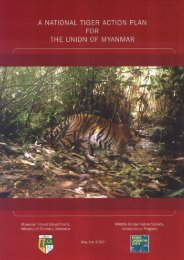Thailand Tiger Action Plan - Global Tiger Initiative
Thailand Tiger Action Plan - Global Tiger Initiative
Thailand Tiger Action Plan - Global Tiger Initiative
Create successful ePaper yourself
Turn your PDF publications into a flip-book with our unique Google optimized e-Paper software.
Activity 4:Activity 5:Activity 6:Work with district attorneys and judges to ensuresubstantial punishments on wildlife crimes against tigersand large ungulates.Overhaul the park ranger system to a higher living andworking standard, and provide rewards and incentivesto encourage patrolling (e.g., patrolling budgets) andother significant morale boosting programs such asperformance-based promotions.Apply landscape-scale ecological and developmentmodels for tiger conservation and engage stakeholdersin development sectors (i.e., roads, oil and gas, mining,power) to minimize and mitigate impacts in sectoralactivities on tiger habitats.Objective 2:Challenge:Provide long-term support for tiger habitat restorationactivitiesMany areas in tiger landscapes and potentiallandscapes are suitable for tiger recovery, but have lowungulate densities due to poaching.Opportunity: Recovery of wild ungulates as tiger prey and habitatmanagement in the tiger source site has started to helprecovery tiger prey and finally tigers.Expected outcome: Habitat is suitable for other wildlife species andnative biodiversity is restored.Duration and locations: 12 years, Tenasserim – WEFCOM as thetiger source site and DP-KY as the potential source site.Activities necessary to accomplish this objective:Activity 7:Activity 8:Activity 9:Activity 10:Activity 11:Activity 12:Promote use of controlled burning in potential andmanageable parts of priority landscapes to maintaingrassland for ungulate recovery.Prevent and suppress fires effectively in evergreenforest areas in priority landscapes to provide good coverand watersheds for tigers and wildlife.Strengthen the reintroduction program of ungulate preywith the ex-situ succeeded species (i.e., sambars, eld’sdeer, hog deer) in suitable habitats.Maintain natural and existing artificial water sources thatbenefit tigers and ungulates especially during droughtperiods in priority landscapes.Establish a system to control invasive species (e.g.,Lantana camera, Mimosa pudica) in priority landscapes.Identify priorities for corridor and habitat restoration.
















